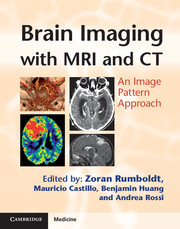Book contents
- Frontmatter
- Contents
- List of contributors
- List of abbreviations
- Preface
- Section 1 Bilateral Predominantly Symmetric Abnormalities
- 1 Hepatic Encephalopathy
- 2 Neurofibromatosis Type 1 – UBOs
- 3 Carbon Monoxide Intoxication
- 4 Pantothenate Kinase-Associated Neurodegeneration (Hallervorden–Spatz Syndrome)
- 5 Methanol Intoxication
- 6 Wilson Disease 12
- 7 Hypoxic Ischemic Encephalopathy in Term Neonates
- 8 Cryptococcosis
- 9 Gangliosidosis GM2
- 10 Leigh Disease
- 11 Deep Cerebral Vein Thrombosis (DCVT)
- 12 Creutzfeldt-Jakob Disease (CJD)
- 13 Global Cerebral Anoxia in Mature Brain
- 14 Wernicke Encephalopathy
- 15 Amyotrophic Lateral Sclerosis
- 16 Glutaric Aciduria Type 1
- 17 Subcortical Band Heterotopia
- 18 Bilateral Perisylvian Polymicrogyria (BPP)
- 19 Lissencephaly
- 20 Herpes Simplex Encephalitis
- 21 Limbic Encephalitis
- 22 CADASIL (Cerebral Autosomal Dominant Arteriopathy with Subcortical Infarcts and Leukoencephalopathy)
- 23 Megalencephalic Leukoencephalopathy with Subcortical Cysts
- 24 Canavan Disease
- 25 HIV Encephalopathy
- 26 Radiation- and Chemotherapy-Induced Leukoencephalopathy
- 27 Leukoaraiosis (Microangiopathy)
- 28 Periventricular Edema in Acute Hydrocephalus
- 29 Hypoglycemia
- 30 X-Linked Adrenoleukodystrophy (X-ALD)
- 31 Periventricular Leukomalacia (PVL)
- 32 Posterior Reversible Encephalopathy Syndrome (PRES, Hypertensive Encephalopathy)
- 33 Alexander Disease
- 34 Metachromatic Leukodystrophy
- 35 Neurodegenerative Langerhans Cell Histiocytosis (ND-LCH)
- 36 Remote Cerebellar Hemorrhage
- 37 Spontaneous Intracranial Hypotension
- Section 2 Sellar, Perisellar and Midline Lesions
- Section 3 Parenchymal Defects or Abnormal Volume
- Section 4 Abnormalities Without Significant Mass Effect
- Section 5 Primarily Extra-Axial Focal Space-Occupying Lesions
- Section 6 Primarily Intra-Axial Masses
- Section 7 Intracranial Calcifications
- Index
- References
37 - Spontaneous Intracranial Hypotension
from Section 1 - Bilateral Predominantly Symmetric Abnormalities
Published online by Cambridge University Press: 05 August 2013
- Frontmatter
- Contents
- List of contributors
- List of abbreviations
- Preface
- Section 1 Bilateral Predominantly Symmetric Abnormalities
- 1 Hepatic Encephalopathy
- 2 Neurofibromatosis Type 1 – UBOs
- 3 Carbon Monoxide Intoxication
- 4 Pantothenate Kinase-Associated Neurodegeneration (Hallervorden–Spatz Syndrome)
- 5 Methanol Intoxication
- 6 Wilson Disease 12
- 7 Hypoxic Ischemic Encephalopathy in Term Neonates
- 8 Cryptococcosis
- 9 Gangliosidosis GM2
- 10 Leigh Disease
- 11 Deep Cerebral Vein Thrombosis (DCVT)
- 12 Creutzfeldt-Jakob Disease (CJD)
- 13 Global Cerebral Anoxia in Mature Brain
- 14 Wernicke Encephalopathy
- 15 Amyotrophic Lateral Sclerosis
- 16 Glutaric Aciduria Type 1
- 17 Subcortical Band Heterotopia
- 18 Bilateral Perisylvian Polymicrogyria (BPP)
- 19 Lissencephaly
- 20 Herpes Simplex Encephalitis
- 21 Limbic Encephalitis
- 22 CADASIL (Cerebral Autosomal Dominant Arteriopathy with Subcortical Infarcts and Leukoencephalopathy)
- 23 Megalencephalic Leukoencephalopathy with Subcortical Cysts
- 24 Canavan Disease
- 25 HIV Encephalopathy
- 26 Radiation- and Chemotherapy-Induced Leukoencephalopathy
- 27 Leukoaraiosis (Microangiopathy)
- 28 Periventricular Edema in Acute Hydrocephalus
- 29 Hypoglycemia
- 30 X-Linked Adrenoleukodystrophy (X-ALD)
- 31 Periventricular Leukomalacia (PVL)
- 32 Posterior Reversible Encephalopathy Syndrome (PRES, Hypertensive Encephalopathy)
- 33 Alexander Disease
- 34 Metachromatic Leukodystrophy
- 35 Neurodegenerative Langerhans Cell Histiocytosis (ND-LCH)
- 36 Remote Cerebellar Hemorrhage
- 37 Spontaneous Intracranial Hypotension
- Section 2 Sellar, Perisellar and Midline Lesions
- Section 3 Parenchymal Defects or Abnormal Volume
- Section 4 Abnormalities Without Significant Mass Effect
- Section 5 Primarily Extra-Axial Focal Space-Occupying Lesions
- Section 6 Primarily Intra-Axial Masses
- Section 7 Intracranial Calcifications
- Index
- References
Summary
Specific Imaging Findings
Spontaneous Intracranial Hypotension (SIH) typically presents with a “sagging brain” imaging appearance with downward displacement of the brain stem and cerebellar tonsils, loss of the basal cisterns, flattened brainstem, bowing of the optic chiasm over the sella, pituitary hyperemia, and effacement of the ventricles and sulci. Diffuse pachymeningeal thickening is bright on FLAIR images with characteristic contrast enhancement, although absent in some cases. Subdural hygromas or less commonly hematomas can also be found. Clinical improvement is not always accompanied by prompt resolution of the MRI findings. Spinal MRI and CT myelography can demonstrate extra-dural fluid collections indicating the location of the CSF leak. MRI may also show meningeal enhancement and dilation of the internal vertebral venous plexi, especially at C1–C2 level. High T2 signal intensity between the spinous processes of C1 and C2 is highly characteristic for SIH.
Pertinent Clinical Information
SIH is a clinical syndrome in which low CSF volume results in orthostatic headache, occurring within 15 min after a change from supine to standing position, and improvement or resolution after lying down. The headache may be diffuse or localized, most commonly to the occipital and suboccipital regions. Associated symptoms in severe cases include nausea, vomiting, photophobia, vertigo, tinnitus, visual loss, diplopia, and even coma. It can occur following a minor trauma, strenuous exercise, sexual activity, or a bout of sneezing or coughing.
- Type
- Chapter
- Information
- Brain Imaging with MRI and CTAn Image Pattern Approach, pp. 75 - 76Publisher: Cambridge University PressPrint publication year: 2012
References
- 1
- Cited by

